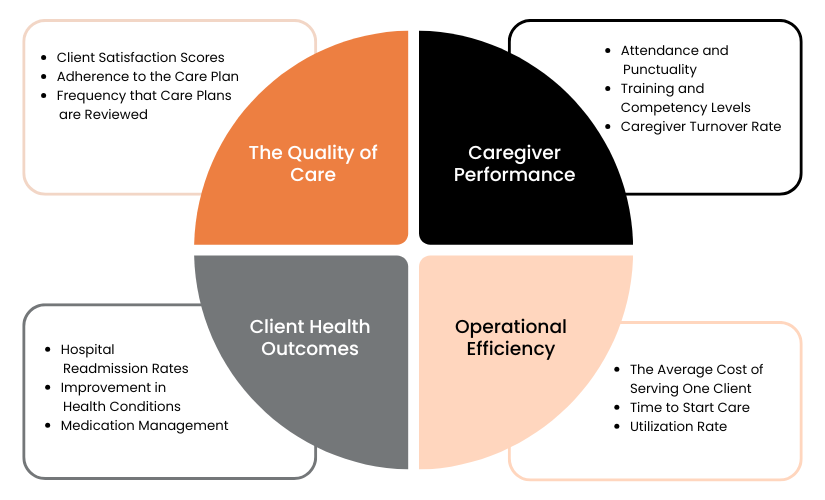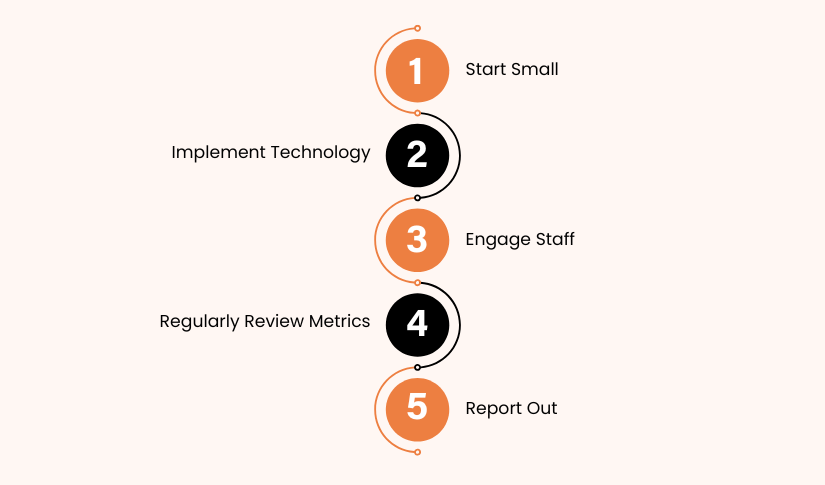
In the latest Benchmarking Report, lack of training has surged to the top of caregiver complaints, climbing from 5th place in 2019 to the #1 spot this year. This shift highlights a critical issue: caregiver training in-home care needs to catch up, and your staff is taking notice.
Suppose you’re among the 70% of providers currently using a professional caregiver training program. A well-audited training program addresses these concerns and can transform your caregivers’ frustrations into a significant asset for your agency.
It’s time for a fresh look at your caregiver training program. Assess its effectiveness by measuring it against these essential metrics to ensure it delivers the quality and impact your caregivers and your agency deserve:
Find out how to evaluate and improve your training program, aligning it with caregiver expectations and advancing agency success.
Home care is a vital service that offers support in terms of day-to-day living, medical care, and overall well-being to those who may require support while staying in their residences. In the increasing demand for home care, much attention has been shifted to quality and effectiveness regarding the level of service offered. Performance metrics in a home care agency are used to measure specific metrics that help agencies evaluate care delivery and identify improvement areas.
When performance metrics are valued and applied effectively, the quality of care can be improved, and this practice is bound to reflect in clients’ satisfaction. Tracking these indicators routinely helps a home care agency pinpoint what it does well and what areas it falters in to make decisions regarding better care and business.
There are some critical performance measures a home care organization can monitor to ensure quality care. These measures can be divided into four main categories: quality of care, client health outcomes, caregiver performance, and operational efficiency.

Quality of care is directly related to how well the delivered care meets the needs and expectations of clients. Quality care has better health outcomes, higher client satisfaction, and greater reputational gains for the agency. A few specific metrics related to quality of care include:
Client Satisfaction Scores
Client satisfaction is a direct measure of quality of care. Agencies can, therefore, gather information concerning their clients’ satisfaction through surveys of clients and families to have them rate their experience of the care extended to them. Some issues raised in the beautiful survey include the reliability and professionalism towards handling one’s case, the effectiveness in delivering the care, and the whole overall experience in this category, implying that an agency is in a position to meet the expectations of the client or is, in turn, exceeding the provided services. Low ones may demonstrate weak points that need to be corrected.
Adherence to the Care Plan
Almost every client likely has a care plan that specifies the details of the kind of care and service the client is expected to receive. Therefore, it is important for caregivers to be monitored on how closely they adhere to the care plans. If the general practice is that they adhere to care plans, then that is a reflection that this agency effectively meets the client’s needs. Deviations from the care plan, however, are strong cues that the caregiver’s communication, caregiver training program, or performance needs improvement.
Frequency that Care Plans are Reviewed
Clients’ needs are subject to frequent change. Common symptoms, such as chronic conditions or recovery from illness/surgery, may define changes in the course of care. An updated review of care is critical in enabling or supporting the care provided. This is a metric that the agencies should track concerning the rate at which care plans are reviewed and updated, showing agency responsiveness to changing client needs. More frequent review of care plans could go a long way in preventing potential problems, such as unmet needs or inappropriate care, which means the clients will realize better outcomes.
The goal of home care is to enhance or maintain the health and well-being of clients. Therefore, the measurement of client health outcomes is a priority performance indicator. Key measures in this area include:
Hospital Readmission Rates
One of the most significant measures of effectiveness in-home care is the readmission rate to hospitals following clients’ discharges. A low hospital readmission rate suggests that the care given is effective in the management of the health condition the client is experiencing. High readmission rates, however, show poor care given at home and can especially be seen with complications that necessitate hospital treatment. An agency could identify healthcare delivery problems and develop strategies to minimize readmissions by monitoring this rate.
Improvement in Health Conditions
For clients suffering from chronic health conditions, there is a need to monitor, over time, how the condition is changing. In the case of a particular client’s condition, this area will involve changes in vital signs, mobility, pain levels, or other health indicators. This area of quantitative input may allow management to confirm whether the care is effective and make improvements associated with better health outcomes. For example, if a client with diabetes achieves better blood sugar control, it suggests that the care plan still works well in managing their condition.
Medication Management
Proper management of medications is crucial for clients who have been diagnosed with a chronic condition or who have acute complex medical conditions. The metrics agencies must track those related to the percentage of clients compliant with their prescribed medications. Poor medication management can lead to deterioration of health or worse outcomes, such as hospitalizations. By tracking medication nonadherence and striving toward adherence, the agencies can play a role in preventing such complications and improving the client’s health.
Caregivers are a significant portion of the home care workforce, and they are the ones to put the services into action. The delivery of services depends on the performance of the caregivers. Monitoring a caregiver’s performance ensures that the worker is qualified and dependable and that the care provided will mirror the quality and standards of the agency. Indicators include:
Attendance and Punctuality
Caregivers need to be available and punctual for the care functions. Agencies can monitor caregiver reliability by knowing their arrival and leaving time, which can indirectly affect care quality. Excessive absences or cases of lateness may portend challenges within a system, such as low job satisfaction, burnout, or inadequate staffing levels. This will ensure consistent and reliable care.
Training and Competency Levels
Caregivers must receive appropriate caregiver training programs to meet their client’s specific needs. The follow-up of employees’ completion of mandatory caregiver training programs supported by tests for assessing caregiver competence will ensure enough preparedness is set for staff to become competent in their positions. Some key performance indicators agencies should be tracking include the percentage of caregivers who have completed mandatory caregiver training and the results of competency assessments. It shows that the caregivers have had careful training and competence; on the other hand, gaps in training indicate that there are requirements for more education or support.
Caregiver Turnover Rate
Home care agencies need help to maintain continuity of client care. By measuring the caregiver turnover rate, agencies can track whether there is something wrong with job satisfaction or working conditions—anything that could cause employees to quit their jobs. When the turnover rate is high, it might indicate that insufficient pay, lack of career advancement opportunities, or bad management is at play. To reduce this turnover, agencies can be better positioned to retain their caregivers and provide continuous care for their clients.
Operational efficiency is a reflection of how the home care agency is utilizing its resources to deliver care. Effective operations drive care to be delivered for less, which means the client is satisfied. Important metrics in this area include:
The Average Cost of Serving One Client
This would include wages for caregivers, administrative costs, and supplies. Managing costs is believed to ensure an agency’s financial health. Yet, the cost containment piece must be balanced with delivering quality care. Track the out-of-pocket per client and grasp opportunities that can offer better efficiencies without jeopardizing client care. For example, efficiencies in scheduling may be identified, or they could help identify technology that could increase administrative efficiencies.
Time to Start Care
If a new client recognizes the need for care services, the agency must quickly arrange for them to start running a service. The time spent before care starts working on a client after referral is critical. When the gap between referral and care is shorter, it means better efficiency and responsiveness, likely contributing to better client experiences. Delays to the initiation of care could culminate in unmet needs or a decay in the care recipient’s condition; therefore, the level of such delays ought to be reduced to a minimum.
Utilization Rate
It keeps track of whether the caregivers’ resources within the agency are being acquired efficiently. This is realized by dividing the hours that caregivers work by the total hours they are expendable. A higher utilization rate is associated with better performance if the agency or department is utilizing its staff; at the same time, a lower rate may indicate underutilization of the caregivers or poor scheduling. Agencies will achieve optimal performance from staff caregivers through optimum utilization rates.
Though performance indicators are handy tools, practices need help to implement. The most common challenges are as follows:
Accurate and dependable data collection is imperative for performance measures to work effectively. However, this can be an area where data collection is sometimes seen as more difficult at home. For instance, collecting satisfaction surveys could take more time with clients than in a fast system in an office. Caregivers would have to be trained to document what they are doing properly. If data are unreliable, then the metrics are not accurately revealing the agency’s performance, and consequently, errors of judgment could be made. Agencies need to invest in rigorous data collection systems and processes such that the information gathered is accurate, complete, and updated.
For the performance metrics to be effective and influential, staff must be buy-in across the board, from the caregivers to the management. However, staff may only accept the idea of metrics if they see it as a way to punish and hold them accountable. To meet this challenge, the agencies have to emphasize creating a culture of continuous improvement, where the metrics will not be instruments of retribution. Still, they will, instead, be instruments of learning and development. Also, involving the staff in developing and implementing the metrics should create buy-in, ensuring that the metrics are relevant and meaningful.
Focusing too heavily on certain metrics can lead to unintended consequences different from the company’s desires. For example, if an agency has cost reduction as a single focus, it may cut corners around quality of care delivery to achieve shorter-term results. A balance must then be made between the different types of metrics so that all the elements of care are monitored appropriately. Home care agencies must reevaluate their metrics to ensure that they are comprehensive and promote the goals and values of the organization.
The world of home care is very dynamic, with almost daily emergence of new regulations, technologies, and best practices. Performance measures need to be dynamic enough for such adjustments. Therefore, an agency needs to revise and update its metrics to ensure that the relevance and effectiveness of the metrics are in tow with the industry changes. This may entail adding new measures, discarding some of the old ones, or even revising some measures to effectively chime with changes in the needs of the client or the practices of care.
Home care agencies can successfully implement and utilize performance measures using the following strategies:

It is daunting to robustly implement a whole set of performance measures simultaneously. Thus, agencies should begin with a relevant, small subset of key performance measures best suited to their immediate needs. With better comfort, more measures can be introduced over time.
Technology can greatly ease performance metrics collection, analysis, and reporting. Most processes, such as data collection, among many others, can be automated using electronic health records, scheduling software, or any other technology that would help track and analyze metrics. Through investment in the required technology, the agency will save much time in the process, and there will be minimal errors in the reports while offering real-time insights into their performance.
It is important to ensure the success of involving staff in developing and implementing all performance metrics. Agencies should seek input from caregivers and other staff members regarding the most relevant measures and means of measurement. Further, training staff on what is most important and how to use this information vis-à-vis the metrics helps ensure that all are on the same page regarding the agency’s vision.
Review performance metrics to monitor progress and success. There should be some set expected frequency for reviewing performance metrics, say monthly or quarterly, and agencies should use what they learn from metrics to address problems and make improvements. Routine review of performance measures also allows for celebrating successes and recognizing staff.
Sharing the results from performance measures openly opens ways for the agency to tell staff, clients, and other stakeholders what has been working and which parts need betterment. Open communication portends successes and challenges and explains which measures are being implemented to address the problem directly. Everyone will then work with open communication to ensure goals are aligned.
A proper caregiver training program is crucial for enhancing the performance metrics of key home care agencies. Quality training that enhances caregiver competency also improves patient satisfaction, operational efficiency, and compliance.
Training programs focusing on essential caregiving skills, such as dementia care, fall prevention, and emergency response—ensure that caregivers are better equipped to handle real-world challenges. Skilled caregivers make fewer errors, require less supervision, and provide higher-quality care, leading to better client outcomes.
Agencies that invest in well-trained caregivers give their clients more trust and confidence in their ability to stay with them. Efficiently trained caregivers in communication skills, cultural sensitivity, and person-centered care develop deep relationships with their clients. This consequently increases patient satisfaction scores and strengthens an agency’s reputation.
Agencies prioritizing training see a reduction in caregiver turnover and absenteeism, leading to more stable staffing levels. Additionally, adequately trained caregivers complete tasks more efficiently, reducing unnecessary visits, minimizing errors in documentation, and ensuring smoother workflows.
State and federal regulations align with caregiver training programs, which an agency must comply with by implementing these programs. By incorporating compliance into the training, these training programs reduce risks associated with improper documentation, patient neglect claims, and workplace safety violations.
Using these crucial measurements to gauge and fine-tune your caregiver training program is a key way to overcome the top concerns elaborated by staff and improve your agency’s quality of care delivery. By offering a variety of generic subjects for your training program, from basic induction to continuous education with specialty courses, while maintaining high completion rates and offering flexible caregiver training, you ensure there is more likelihood that your caregiver training will become one of the major assets to your organization.
A well-rounded caregiver training program equals your caregivers being better prepared and feeling valued and supported. This can enormously build your agency’s reputation and make it more appealing to clients or caregivers.
Gear up your caregiver training program and ensure it meets critical standards with Learn2Care. Our end-to-end solutions help agencies bridge current gaps while anticipating future needs. By choosing Learn2Care, you equip your agency with a training program that enhances staff satisfaction, improves care quality, and strengthens your competitive edge in the home care industry. Discover how we can transform your training program into a powerful driver of success.
Contact us to inquire about our state-wise training courses and take the first step towards upskilling your team with a 14-day free trial!